-
 Bitcoin
Bitcoin $106,754.6083
1.33% -
 Ethereum
Ethereum $2,625.8249
3.80% -
 Tether USDt
Tether USDt $1.0001
-0.03% -
 XRP
XRP $2.1891
1.67% -
 BNB
BNB $654.5220
0.66% -
 Solana
Solana $156.9428
7.28% -
 USDC
USDC $0.9998
0.00% -
 Dogecoin
Dogecoin $0.1780
1.14% -
 TRON
TRON $0.2706
-0.16% -
 Cardano
Cardano $0.6470
2.77% -
 Hyperliquid
Hyperliquid $44.6467
10.24% -
 Sui
Sui $3.1128
3.86% -
 Bitcoin Cash
Bitcoin Cash $455.7646
3.00% -
 Chainlink
Chainlink $13.6858
4.08% -
 UNUS SED LEO
UNUS SED LEO $9.2682
0.21% -
 Avalanche
Avalanche $19.7433
3.79% -
 Stellar
Stellar $0.2616
1.64% -
 Toncoin
Toncoin $3.0222
2.19% -
 Shiba Inu
Shiba Inu $0.0...01220
1.49% -
 Hedera
Hedera $0.1580
2.75% -
 Litecoin
Litecoin $87.4964
2.29% -
 Polkadot
Polkadot $3.8958
3.05% -
 Ethena USDe
Ethena USDe $1.0000
-0.04% -
 Monero
Monero $317.2263
0.26% -
 Bitget Token
Bitget Token $4.5985
1.68% -
 Dai
Dai $0.9999
0.00% -
 Pepe
Pepe $0.0...01140
2.44% -
 Uniswap
Uniswap $7.6065
5.29% -
 Pi
Pi $0.6042
-2.00% -
 Aave
Aave $289.6343
6.02%
What does the sudden drop of ADX in DMI mean? Is the trend over?
A sudden ADX drop signals weakening trend strength but doesn’t confirm a trend reversal, urging traders to analyze price action and other indicators for context.
Jun 14, 2025 at 12:35 pm
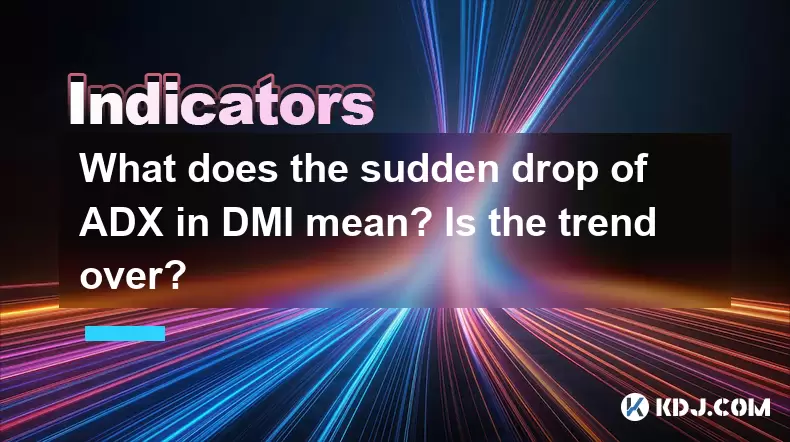
Understanding ADX in DMI
The ADX (Average Directional Index) is a component of the DMI (Directional Movement Indicator), which is widely used by traders to assess the strength of a trend. The DMI consists of three lines: the +DI (Positive Directional Indicator), the -DI (Negative Directional Indicator), and the ADX line itself. While +DI and -DI help determine the direction of the trend, the ADX line measures its strength.
A sudden drop in ADX may raise concerns among traders who rely on this indicator for trend analysis. It's crucial to understand that ADX does not indicate whether the trend is bullish or bearish, only how strong it currently is. A reading above 25 typically suggests a strong trend, while anything below 20 indicates a weak or non-existent trend.
What Causes ADX to Drop Suddenly?
There are several reasons why the ADX might experience a sharp decline:
- Market consolidation: When price action narrows and lacks directional movement, the ADX naturally decreases because there’s less momentum.
- Range-bound conditions: In sideways markets, neither buyers nor sellers gain control, leading to diminished trend strength.
- Trend exhaustion: After a prolonged uptrend or downtrend, a drop in ADX can signal that the trend is losing steam.
- False breakouts: Sometimes, a brief spike in price may create a false impression of a new trend, which quickly collapses, causing ADX to fall.
It’s essential to interpret these changes within the broader context of price action and other technical indicators to avoid misjudging the market condition.
Does a Sudden ADX Drop Mean the Trend Is Over?
Not necessarily. A declining ADX value indicates weakening trend strength but doesn't confirm the end of the trend. Here’s what you should consider:
- ADX is lagging: Since ADX is based on moving averages, it reacts to past price behavior rather than predicting future moves. Therefore, a drop may occur after the trend has already started to fade.
- Check DI crossovers: If the +DI crosses below the -DI, it could suggest a reversal in trend direction, especially if confirmed by other tools like candlestick patterns or volume spikes.
- Look at support/resistance levels: Even if ADX declines, price may still be respecting key levels, suggesting that the trend could resume after a pause or correction.
In short, a falling ADX should serve as a cautionary signal rather than an immediate sell or buy alert.
How to Confirm Whether the Trend Is Still Valid
To make informed decisions when ADX drops suddenly, traders can use the following techniques:
- Price action analysis: Observe if higher highs and higher lows continue in an uptrend or lower highs and lower lows persist in a downtrend.
- Volume confirmation: A healthy trend usually comes with rising volume during directional moves. A drop in volume alongside falling ADX may confirm weakness.
- Moving average filters: Use longer-term moving averages like the 50-day or 200-day EMA to see if the price remains above or below them.
- Oscillators for divergence: Tools like MACD or RSI can reveal hidden divergences that may indicate trend reversals before they happen.
- Timeframe correlation: Check multiple timeframes—what appears as a breakdown on a 1-hour chart may just be a retracement on a daily chart.
By combining these methods with DMI readings, traders can better assess whether the trend is likely to continue or reverse.
Strategies to Adopt During ADX Decline
When ADX starts to fall, it’s wise to adjust your trading strategy accordingly:
- Switch to range trading: If the market becomes consolidative, look for opportunities to trade bounces off support and resistance.
- Reduce position size: Lowering exposure helps manage risk when trend clarity diminishes.
- Use tighter stop losses: With reduced momentum, volatility can increase unpredictably, making wider stops more dangerous.
- Monitor breakout signals: Watch for potential new trends forming after consolidation phases. Breakouts from key levels with volume surges may offer fresh entries.
- Avoid overtrading: Many traders fall into the trap of chasing moves during weak trending environments. Patience often pays off during such periods.
Each of these strategies requires careful execution and should be tested on historical data or demo accounts before applying them in live markets.
Frequently Asked Questions
Q: Can ADX rise again after a sudden drop?
Yes, ADX can rebound if the price resumes a strong directional move. This often happens after periods of consolidation or when new fundamental news impacts the asset.
Q: Should I exit my position if ADX drops below 20?
Not automatically. Evaluate the broader market structure and whether the trend is still intact. Consider partial exits or trailing stops instead of full liquidation.
Q: How reliable is ADX compared to other trend indicators?
ADX is highly regarded for measuring trend strength, but no single indicator is foolproof. Combining it with tools like MACD, RSI, or Bollinger Bands increases reliability.
Q: Does ADX work well in cryptocurrency markets?
Cryptocurrency markets are known for high volatility and frequent trend shifts. ADX works best in crypto when paired with volatility filters and volume analysis due to the erratic nature of price movements.
Disclaimer:info@kdj.com
The information provided is not trading advice. kdj.com does not assume any responsibility for any investments made based on the information provided in this article. Cryptocurrencies are highly volatile and it is highly recommended that you invest with caution after thorough research!
If you believe that the content used on this website infringes your copyright, please contact us immediately (info@kdj.com) and we will delete it promptly.
- 2025-W Uncirculated American Gold Eagle and Dr. Vera Rubin Quarter Mark New Products
- 2025-06-13 06:25:13
- Ruvi AI (RVU) Leverages Blockchain and Artificial Intelligence to Disrupt Marketing, Entertainment, and Finance
- 2025-06-13 07:05:12
- H100 Group AB Raises 101 Million SEK (Approximately $10.6 Million) to Bolster Bitcoin Reserves
- 2025-06-13 06:25:13
- Galaxy Digital CEO Mike Novogratz Says Bitcoin Will Replace Gold and Go to $1,000,000
- 2025-06-13 06:45:13
- Trust Wallet Token (TWT) Price Drops 5.7% as RWA Integration Plans Ignite Excitement
- 2025-06-13 06:45:13
- Ethereum (ETH) Is in the Second Phase of a Three-Stage Market Cycle
- 2025-06-13 07:25:13
Related knowledge
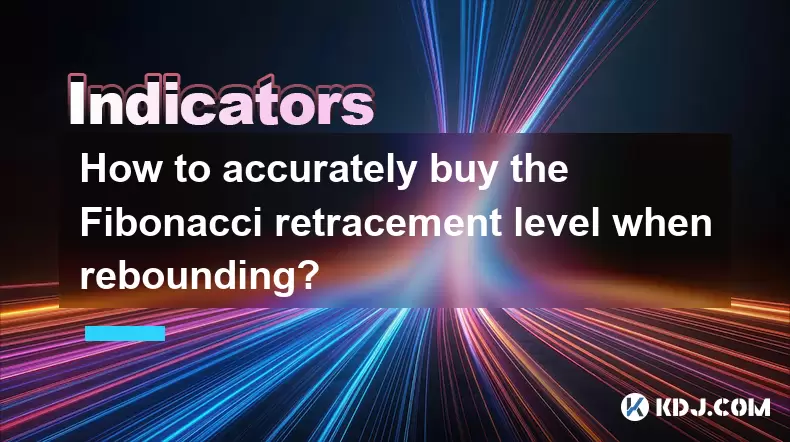
How to accurately buy the Fibonacci retracement level when rebounding?
Jun 16,2025 at 09:56pm
Understanding the Fibonacci Retracement ToolThe Fibonacci retracement is a popular technical analysis tool used by traders to identify potential support and resistance levels. It is based on the idea that markets will retrace a predictable portion of a move before continuing in the original direction. The key Fibonacci levels are typically 23.6%, 38.2%,...

How to set the stop profit point after the high-level propeller pattern?
Jun 16,2025 at 08:04pm
Understanding the High-Level Propeller PatternThe high-level propeller pattern is a technical analysis formation often observed in cryptocurrency trading charts. It typically appears at significant price peaks and signals potential reversals. The pattern consists of a large candlestick with long upper and lower shadows, resembling a propeller, indicatin...

When is the most reasonable stop loss after the three crows pattern?
Jun 16,2025 at 08:14pm
Understanding the Three Crows Pattern in Cryptocurrency TradingThe three crows pattern is a well-known bearish reversal signal in technical analysis, particularly relevant in volatile markets like cryptocurrency. It typically appears at the end of an uptrend and consists of three consecutive long red (or bearish) candles with progressively lower closes....
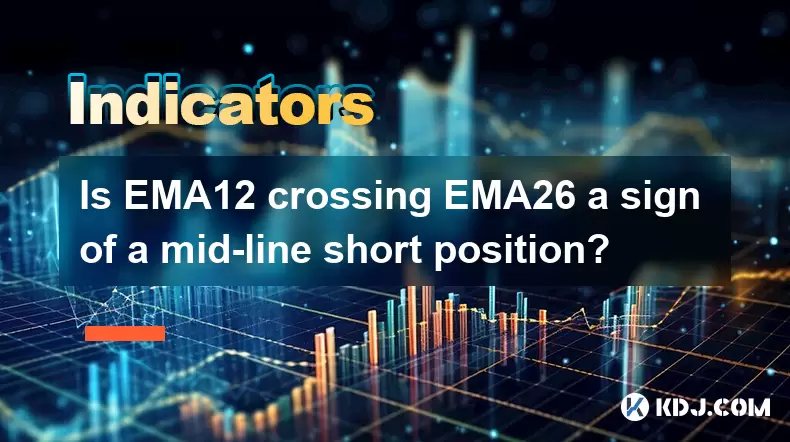
Is EMA12 crossing EMA26 a sign of a mid-line short position?
Jun 16,2025 at 07:22pm
Understanding EMA12 and EMA26 in Cryptocurrency TradingIn the world of cryptocurrency trading, Exponential Moving Averages (EMAs) are widely used tools for analyzing price trends. Specifically, the EMA12 and EMA26 are two of the most commonly referenced EMAs among traders. The EMA12 represents a short-term moving average calculated over the past 12 time...
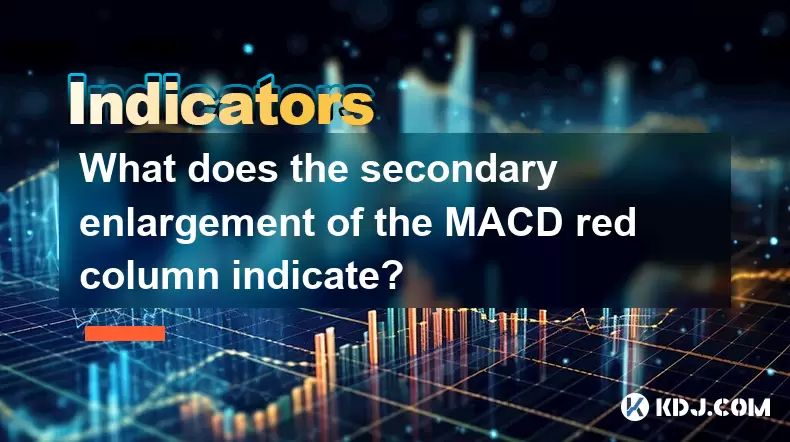
What does the secondary enlargement of the MACD red column indicate?
Jun 16,2025 at 07:49pm
Understanding the MACD Indicator and Its ComponentsThe Moving Average Convergence Divergence (MACD) is a widely used technical analysis tool in cryptocurrency trading. It consists of three main components: the MACD line, the signal line, and the MACD histogram. The histogram, represented as red or green bars, reflects the difference between the MACD lin...
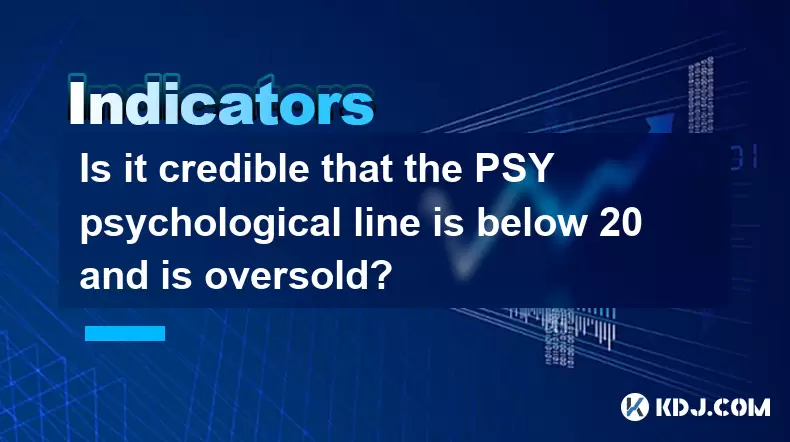
Is it credible that the PSY psychological line is below 20 and is oversold?
Jun 16,2025 at 10:14pm
Understanding the PSY Psychological Line IndicatorThe PSY psychological line indicator is a technical analysis tool used to gauge the sentiment of the market by measuring the number of rising days over a specific period. Typically, it operates on a scale from 0 to 100, where values above 80 suggest an overbought condition and values below 20 indicate an...

How to accurately buy the Fibonacci retracement level when rebounding?
Jun 16,2025 at 09:56pm
Understanding the Fibonacci Retracement ToolThe Fibonacci retracement is a popular technical analysis tool used by traders to identify potential support and resistance levels. It is based on the idea that markets will retrace a predictable portion of a move before continuing in the original direction. The key Fibonacci levels are typically 23.6%, 38.2%,...

How to set the stop profit point after the high-level propeller pattern?
Jun 16,2025 at 08:04pm
Understanding the High-Level Propeller PatternThe high-level propeller pattern is a technical analysis formation often observed in cryptocurrency trading charts. It typically appears at significant price peaks and signals potential reversals. The pattern consists of a large candlestick with long upper and lower shadows, resembling a propeller, indicatin...

When is the most reasonable stop loss after the three crows pattern?
Jun 16,2025 at 08:14pm
Understanding the Three Crows Pattern in Cryptocurrency TradingThe three crows pattern is a well-known bearish reversal signal in technical analysis, particularly relevant in volatile markets like cryptocurrency. It typically appears at the end of an uptrend and consists of three consecutive long red (or bearish) candles with progressively lower closes....

Is EMA12 crossing EMA26 a sign of a mid-line short position?
Jun 16,2025 at 07:22pm
Understanding EMA12 and EMA26 in Cryptocurrency TradingIn the world of cryptocurrency trading, Exponential Moving Averages (EMAs) are widely used tools for analyzing price trends. Specifically, the EMA12 and EMA26 are two of the most commonly referenced EMAs among traders. The EMA12 represents a short-term moving average calculated over the past 12 time...

What does the secondary enlargement of the MACD red column indicate?
Jun 16,2025 at 07:49pm
Understanding the MACD Indicator and Its ComponentsThe Moving Average Convergence Divergence (MACD) is a widely used technical analysis tool in cryptocurrency trading. It consists of three main components: the MACD line, the signal line, and the MACD histogram. The histogram, represented as red or green bars, reflects the difference between the MACD lin...

Is it credible that the PSY psychological line is below 20 and is oversold?
Jun 16,2025 at 10:14pm
Understanding the PSY Psychological Line IndicatorThe PSY psychological line indicator is a technical analysis tool used to gauge the sentiment of the market by measuring the number of rising days over a specific period. Typically, it operates on a scale from 0 to 100, where values above 80 suggest an overbought condition and values below 20 indicate an...
See all articles

























































































